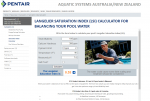As I said, your water's CSI has to be way out of balance for long periods of time for scaling to become a problem. Saturation balance simply indicates the potential for scaling or etching, it says nothing about the rate at which those phenomenon will happen. SWG's are the most susceptible to scaling because they generate chlorine electrochemically and a consequence of the fast pH rise inside the cell near the anode plates causes calcium to want to precipitate faster there. Heaters are only susceptible to scale if the water saturation is too positive and they are run at high temperatures for long periods of time or shutdown prematurely before allowing time for the heat exchanger to cool off. Plaster scaling is only seen when the CSI > +0.6 and even then it is very slow. Typically the saturation needs to be closer to +1.0 for there to be any noticeable deposits.
There is no such thing as "effectiveness" when talking about chlorine and pH. That is an industry term that has no scientific grounding and it's designed to scare people into buying products or treating their pools in a specific way. Active chlorine concentrations, ie, the concentrations of hypochlorous acid (HOCl) and hypochlorite anion (OCl-), do vary with pH. At a pH of 7.5, the amounts of HOCl and OCl- are roughly equal. In a pool with no cyanuric acid, the variation can be quite extreme between 7.2 and 7.8. In a pool with cyanuric acid, the amount of variation is quite small on an absolute scale and there is no need to worry about pH and active chlorine concentration. As long as TFP recommended levels are followed, there is ample amounts of sanitizer in the water at all pH values from 7.0 to 8.0. The only time pH makes a difference is when one needs to SLAM a green pool as it is better to drop the pH first to 7.2 and then start the SLAM. That produces the highest concentration of HOCl in the water and alleviates some of the pH rise issues when adding large quantities of liquid chlorine to a pool all at once.
If you are operating your pool with no CYA stabilizer and relying on ORP control, then your HOCl and OCl- concentrations are going to vary a lot with pH. You may still have enough sanitizer in your water to combat disease transmission and algae growth but the harshness of that sanitizer, as defined by the HOCl concentration, on clothes, swim suits and hair will be a lot higher. With a pH of 7.5, 0 ppm CYA and 1ppm FC, HOCl concentration is 0.484ppm. When the pH rises to 7.8, the HOCl drops to 0.320ppm. With 30ppm CYA in the water those values are 0.013ppm and 0.011ppm respectively. 0.011ppm HOCl corresponds to ~ 650mV of ORP which is the minimum for sanitation (pathogen control). TFP typically recommends 2-3ppm FC with 30ppm CYA which raises the HOCl above 0.03ppm or 3X the minimum value needed for sanitation. However, one can easily see that having some CYA in the water improves the water quality by not having so much HOCl present which is very irritating to eyes, mucosa, swim suits, hair, etc.


